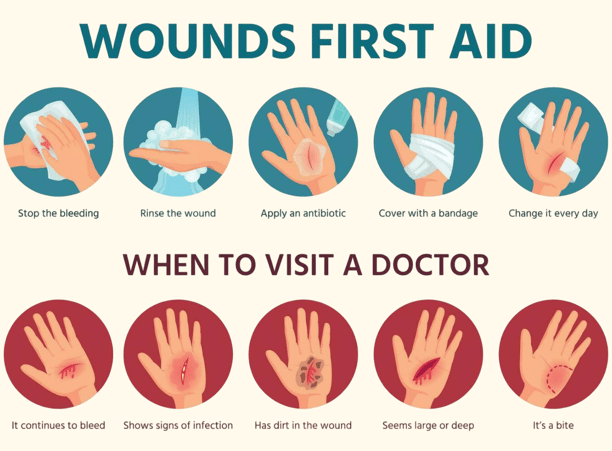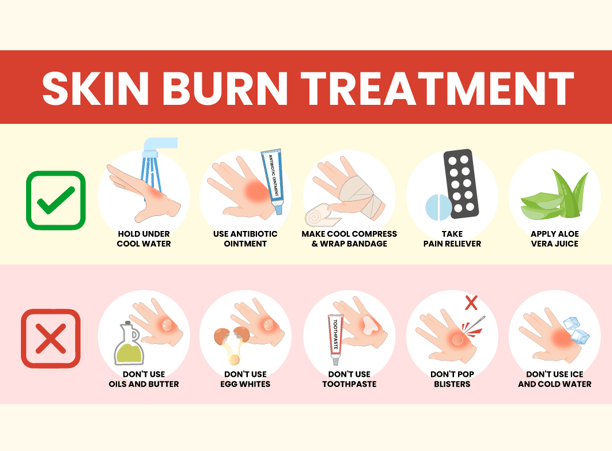First Aid
Learn how to treat wounds, perform CPR, and handle fractures. In survival situations, having basic first aid knowledge can save lives. Understanding how to treat injuries like wounds, fractures, or cardiac emergencies ensures that you can provide immediate care before professional help is available. Here’s a detailed explanation of each skill and how to perform them effectively.
KNOW BASIC SURVIVAL SKILLS
12/10/20243 min read
First Aid
Learn how to treat wounds, perform CPR, and handle fractures. In survival situations, having basic first aid knowledge can save lives.
Understanding how to treat injuries like wounds, fractures, or cardiac emergencies ensures that you can provide immediate care before professional help is available. Here’s a detailed explanation of each skill and how to perform them effectively.


1. How to Treat Wounds
A. Why It’s Important:
Prevents infections that can worsen injuries or become life-threatening.
Helps stop excessive bleeding, which can lead to shock or death.
Promotes faster healing and reduces complications.
B. Types of Wounds and Their Treatment:
Cuts and Scrapes:
Clean the Wound:
Wash hands thoroughly.
Rinse the wound with clean water to remove dirt and debris.
Pat dry with sterile gauze.
Stop Bleeding:
Apply firm pressure using a clean cloth or gauze until the bleeding stops (usually 5-10 minutes).
Dress the Wound:
Apply an antibiotic ointment to prevent infection.
Cover with a sterile bandage.
Monitor:
Change the dressing daily and watch for signs of infection (redness, swelling, pus).
Deep Cuts or Punctures:
Stop the Bleeding:
Apply direct pressure.
Do Not Remove Embedded Objects:
Leave the object in place and secure it with bandages until professional help is available.
Seek Immediate Medical Help:
These wounds may require stitches or further treatment.
Burns:
For Minor Burns:
Cool the burn with cold running water for at least 10 minutes.
Apply a sterile, non-stick dressing.
For Severe Burns:
Do not apply ice, ointments, or butter.
Cover with a clean, loose cloth and seek medical attention.
2. How to Perform CPR (Cardiopulmonary Resuscitation)
A. Why It’s Important:
Restores blood circulation and oxygen flow to the brain and organs during cardiac arrest.
Can keep someone alive until professional help arrives.
B. Steps to Perform CPR on Adults:
Check Responsiveness:
Shake the person gently and ask loudly, “Are you okay?”
If no response, call for emergency help.
Check Breathing:
Look, listen, and feel for breathing for no more than 10 seconds.
If the person isn’t breathing or breathing abnormally (e.g., gasping), start CPR.
Start Chest Compressions:
Hand Position:
Place the heel of one hand on the centre of the chest (lower half of the breastbone).
Put your other hand on top and interlock your fingers.
Compression Depth and Rate:
Push hard and fast — compress the chest about 2 inches (5 cm) deep.
Maintain a rhythm of 100-120 compressions per minute (similar to the beat of “Stayin' Alive” by the Bee Gees).
Allow the chest to rise fully between compressions.
Rescue Breaths (If Trained):
After 30 compressions, give 2 rescue breaths.
Tilt the head back slightly, pinch the nose, and give a breath that makes the chest rise visibly.
Continue CPR:
Alternate between 30 compressions and 2 breaths until help arrives or the person starts breathing normally.
Note: For children and infants, adjust compression depth and hand placement. For infants, use two fingers for compressions.
3. How to Handle Fractures
A. Why It’s Important:
Prevents further injury or complications like bone misalignment.
Reduces pain and stabilizes the injury until professional care is available.
B. Signs of a Fracture:
Swelling, bruising, or deformity.
Pain that worsens with movement or pressure.
Inability to move the affected area.
C. How to Treat Fractures:
Immobilize the Injury:
Keep the injured area still to prevent further damage.
Use a splint to stabilize the limb. You can improvise with items like wood, cardboard, or rolled-up newspaper.
For Arm Fractures:
Support with a sling to keep the arm close to the body.
For Leg Fractures:
Immobilize the leg using a splint on both sides of the limb and secure it with cloth or bandages.
Reduce Swelling:
Apply an ice pack wrapped in a cloth for 15-20 minutes to reduce swelling and pain.
Elevate the Limb:
Raise the injured area above heart level if possible to minimize swelling.
Do Not Attempt to Realign Bones:
Leave any realignment to medical professionals to avoid causing more harm.
Seek Medical Help Immediately:
Fractures require professional diagnosis and treatment.
Knowing how to treat wounds, perform CPR, and handle fractures is crucial in emergency situations where medical help may be delayed. These skills empower you to provide immediate care, increasing the chances of survival and recovery for yourself and others.




